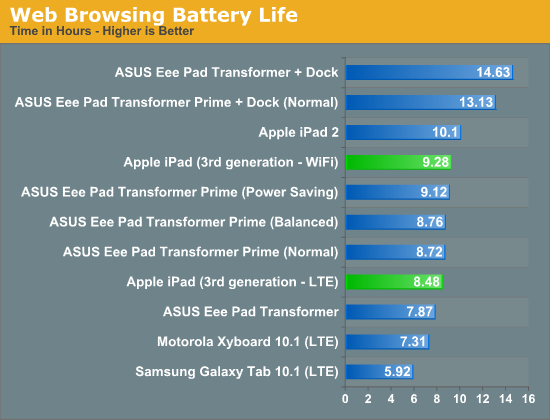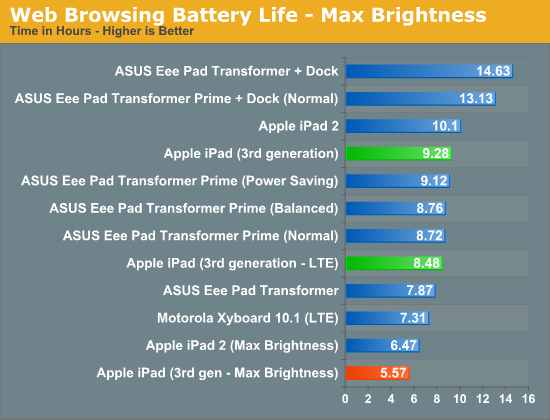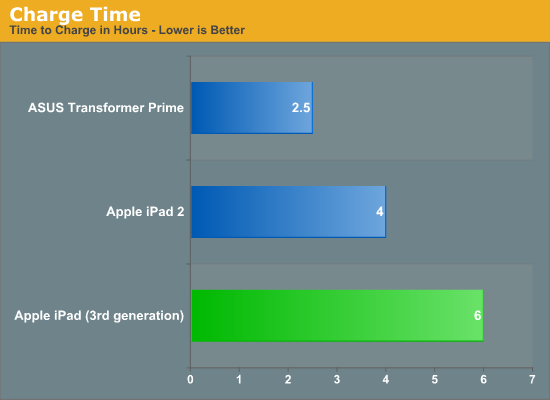The Apple iPad Review (2012)
by Vivek Gowri & Anand Lal Shimpi on March 28, 2012 3:14 PM ESTBattery Life
For a company that has been so laser focused on reducing weight and device thickness, the new iPad actually growing in both of these dimensions was unexpected. From a technical standpoint, the tradeoff makes sense. The new Retina Display consumes significantly more power than its predecessor, as do the A5X and MDM9600 baseband. Both of those ASICs are still built on a 4x-nm LP process and will surely increase power consumption over the iPad 2.
With more transistors switching on the same process node and a display (and backlight) driving more pixels at the same brightness, the battery either had to be larger or battery life would suffer. Apple understandably chose the former and the new iPad ships with a 42.5Wh battery—the largest we've ever seen used in an ARM tablet. The new iPad's battery is so large it's even bigger than what Apple uses in the 11-inch MacBook Air, and it's within striking distance of the 50Wh unit you'll find in the 13-inch model. I do believe this move says a lot about how Apple sees the iPad moving up in the world, but I'll get to a discussion about that later.
With a 70% larger battery than the iPad 2 but with more power hungry components inside, how does the new iPad fare in real world usage? Subjectively: it doesn't last as long as its predecessor. Objectively, our numbers seem to agree.
Our web browsing battery life test browses through dozens of web pages, pausing on each to simulate reading time, until the battery is depleted. All of our tests are run at the same brightness settings (200 nits) to ensure we are comparing apples to apples.

On WiFi we measured an 8% decrease in battery life compared to the iPad 2—nothing huge but not insignificant either. Fall off of WiFi and depend on LTE and you'll see around a 9% decrease in battery life, again—noticeable but not unusable.
I also threw in numbers from the Motorola Xyboard 10.1, an LTE enabled Android tablet running 3.2. Equipped with a much smaller battery (~26Wh), the Xyboard 10.1 delivered 7.31 hours in our LTE web browsing test. The new iPad managed to last 16% longer on a single charge—a smaller advantage than you'd expect given the 70% increase in battery capacity, showing just how much power the new Retina Display and its backlight consume.
The iPad is more than usable on long flights or throughout the day without being tethered to a wall outlet, but in practice you can expect a decrease in battery life compared to last year's model.
Keep in mind that these values are all at 200 nits (roughly 70% brightness on the iPad). If you use the iPad at max brightness (~400 nits) you'll see considerably lower numbers:

In our web browsing test, at max brightness, we saw 5 hours and 34 minutes of continuous use before the battery died. The iPad 2 incurs a similar penalty, lasting under 7 hours in the same test. Do keep this in mind if you need to get a lot of untethered use out of the new iPad. In order to come close to Apple's battery life estimates you'll have to be below 70% brightness.
Charging
Despite the significant increase in battery capacity, Apple continues to ship the new iPad with the same 10W USB power adapter as the previous two models. You can charge the iPad via a Mac/PC USB port that implements the USB charging spec, however doing so will take a minor eternity to fully charge the tablet. Just as before, the new iPad will not charge off of a USB port if the tablet is awake; it will only charge when locked/asleep. The convenience of having a USB based charger is evident, but you'll want to stick with the 10W adapter to actually charge the iPad.
Charging the larger battery does take longer. If we measure from a completely dead state to when the iPad indicates that it's fully charged the increase in time is approximately 50%, from 4 hours with the iPad 2 to 6 hours with the new iPad. ASUS' Transformer Prime, by comparison, requires only 2.5 hours as it ships with an 18W charger. And no, you can't use ASUS' charger to speed up charge times on the new iPad—when connected, the TF Prime charger will only supply 9W to the iPad.

The story doesn't end there however. While the iPad 2 will draw 0W after its 4 hour charge cycle is complete, the new iPad will continue to draw around 3W after it claims to be fully charged. This will continue for roughly another hour at which point the power adapter will draw anywhere from 0.1—0.6W.
Note that when running at full brightness and with a heavy GPU load (e.g. Infinity Blade 2), the power adapter can't supply enough to keep the iPad charged and drive the display/internal components.
There's no good solution here other than for Apple to start shipping the iPad with a higher wattage power adapter. I do believe faster charge times are going to be necessary if Apple is keen on sticking with this larger battery, not to mention the usage issues of not being able to maintain charge equilibrium under load.
Thermals
The increase in power consumption of the new iPad also manifests in the form of increased heat production. A 163mm^2 SoC built on a 45nm LP process is a serious chip. Although it doesn't run hot enough to require active cooling, the SoC alone is responsible for a couple of watts of the iPad's TDP under heavy load. Combine that with a 45nm LTE modem and the heat put off by the more powerful backlight and you've got a recipe for a noticeably warmer device.
Does the new iPad get warmer than the previous one? Absolutely. I would even go as far as to say that it can get uncomfortably warm, but it never gets too hot to hold. If you've used any of the modern Mac notebooks, I don't believe it's anywhere near as bad.
When holding the new iPad in portrait mode, with the home button at the bottom, the lower left corner of the device ends up being the warmest. Along the left edge of the iPad is where the logic board resides, and the lower half is home to the A5X SoC. Under load, particularly a heavy GPU load (e.g. playing a 3D game), this area is going to heat up quickly.
I took several measurements using a contactless IR thermometer in the same ambient conditions on a new iPad vs. the iPad 2. The results are below:
| Thermal Comparison (Max Temperature) | |||||
| iPad 2 | iPad (3rd generation) | ||||
| Web Browsing (2 hours) | 32.7˚C | 37.6˚C | |||
| Infinity Blade 2 (1 hour) | 34.2˚C | 41.9˚C | |||
Again, I don't believe this is a deal breaker but it's the obvious result of remaining on Samsung's 45nm LP process combined with a more power hungry display/backlight. I suspect there will be improvements in efficiency on the display side over time, but I can't see the Retina Display being any lower power than the iPad 2's 1024 x 768 screen. The real avenue for improvement will be when Apple shifts to 28/32nm silicon for the SoC and LTE modem. If you want a cooler running iPad, you'll have to wait until next year for that.










234 Comments
View All Comments
Steelbom - Thursday, March 29, 2012 - link
I'm curious why we didn't see any graphics benchmarks from the UDK like with the iPhone 4S review?Craig234 - Thursday, March 29, 2012 - link
Wow, this is good to buy... 'if you are in desperate need for a tablet'?That's a pretty weak recommendation, I expected a much stronger endorsement based on the review.
Chaki Shante - Friday, March 30, 2012 - link
Great, thorough review, thanks Anand et al.Given the sheer size of the SoC (like 4x larger then Tegra2 or OMAP4430, and 2x Tegra3), you'd bet Apple has the fastest current SoC, at least GPU-wise.
This SoC is just huge and Apple's margin is certainly lowered. Is this sustainable on the long run ?
I wonder if any other silicon manufacturer could make same size devices (not technologically but from a price perspective) and expect to sell them.
dagamer34 - Friday, March 30, 2012 - link
No one else needs to crank out so many chips that are the same. Also, other companies will be waiting long enough to use 28nm, so there's little chance they'll be hitting the same size as the A5X on 45nm.Aenean144 - Friday, March 30, 2012 - link
Since Apple is both the chip designer/licensee and hardware vendor, it saves them the cost of paying a middleman. Ie, Nvidia has to make a profit on a Tegra sale, Apple does not, and can afford a more expensive chip from the fab compared to the business component chain from Asus to Nvidia to GF/TSMC and other IP licensees.I bet there is at least 50% margin somewhere in the transaction chain from Asus to Nvidia to GF/TSMC. Apple may also have a sweetheart IP deal from both ARMH and IMGTEC that competitors may not have.
shompa - Friday, March 30, 2012 - link
@Aenean144Tegra2 cost 25 dollars for OEMs and 15 dollars to manufacture. A5 cost Apple 25 dollars to manufacture. By designing its own SoC Apple got 30% larger SoC at the same price as Android OEMs.
Tegra3 is huge. That is a problem for Nvidia. It costs at least 50% more to manufacture. Nvidia is rumored to charge 50 dollar for the SoC.
A5X is 50%+ larger then Tegra3. Depending of yields it cost Apple 35-50 dollar per SoC.
The integrated model gives Apple cheaper SoCs, but also custom designed for their needs. Apple have a long history of Accelerating stuff in its OS. Back in 2002 it was AltiVec. Encoding a DVD on a 667mhz powerbook took 90 minutes. The fastest X86 AMD 1.5ghz it took 15 hours. (and it was almost impossible to have XP not bluescreen for 15 hours under full load). Since 2002 Apple accelerate OSX with Quarz Extreme. Both these techniques are now used in iOS with SIMD acceleration and GPU acceleration. Its much more elegant then the brute force X86 approach. Integrated makes it possible to use slower, cheaper and more efficient designs.
shompa - Friday, March 30, 2012 - link
The A5X SoC is a disaster. Its a desperation SoC that had to be implemented when TSMC 28nm process slipped almost 2 years. That is the reason why Apple did not tape out a 32nm A5X on Samsung. PA Semi had to crank out a new tapeout fast with existing assets. So they took the A5 and added 2 more graphics core.The real A6 SoC is probably ready since long back, but TSMC cant deliver enough wafers. The rumored tapeout for A6 was mid 2011. Apple got test wafers from TSMC in june and another batch of test wafers in october. Still at this point Apple believed they would use TSMC for Ipad3.
ARM is about small, cheap and low power SoCs. That is the future of computing. The A5X is larger then many X86 chips. Technically Intel manufactures many of its CPUs cheaper then Apple manufactures the A5X SoC. That is insane.
stimudent - Friday, March 30, 2012 - link
Products reviews are fun to look at, but where there's a bright side, there is always a dark side. Maybe product scoring should also reflect how a manufacturer treats its employees.name99 - Friday, March 30, 2012 - link
You mean offers them a better wage than they could find in the rest of China, and living conditions substantially superior to anywhere else they could work?Yes, by all means let's use that scoring.
Or perhaps you'd like to continue to live your Mike Daisey dystopia because god-forbid that the world doesn't conform to your expectations?
Craig234 - Friday, March 30, 2012 - link
I'm all for including 'how a company treats its employees' and other social issues; but I'd list them separately, not put them in a product rating.